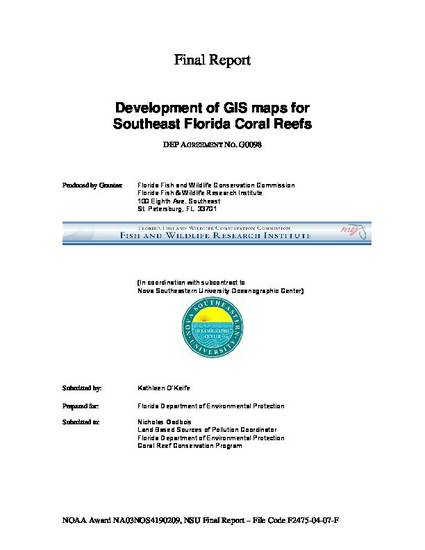
The present report outlines the results of an integrated mapping project undertaken to provide habitat maps of the shallow Palm Beach County seafloor between the 6m and 35m contours. This study is a continuation of a similar mapping study undertaken in Broward County, and results were produced such that a seamless and fully compatible mapping product is now available for both counties. The study area stretched from 26.4429o (E. Linton Blvd) in the south to 26.9590o (Jupiter Inlet) in the north. Compatibility with other, in particular NOAA, mapping products was also assured. Data types used in this mapping effort included Laser Airborne Depth Sounder (LADS) bathymetry, and single-beam acoustic seafloor discrimination, as well as ecological assessments and groundtruthing. The method used for acoustic seafloor discrimination was based on the first echo and its associated tail, and on the second echo returns of a 38 kHz and a 420 kHz signal. The survey system employed was an at-source-logging Biosonic transducers and Biosonics recording software. Data analysis used QTC Impact software and a suite of in-house custom-developed algorithms that allowed development of an acoustically-based biomass model for gorgonians, algae and barrel sponges (Xestospongia muta). A series of controlled experiments and field verifications verified that it was possible to acoustically distinguish between different scattering classes correlated to different seafloor types and different biomasses of scattering organisms.
Two sets of mapping products were produced. In Phase I, polygons were produced by visual interpretation of LADS bathymetry and input of the acoustic ground discrimination. Phase I maps were based on original habitat definitions by the NOAA biogeography program as previously adapted for the Broward County habitat mapping program. The final map showed a well-developed linear reef complex, which is a continuation of the outer reef of Broward County. Also, the middle reef of Broward County was observed in the southern part of Palm Beach County as a linear reef feature. In the northern area of Palm Beach County, a series of hardground ridges, likely a drowned headland, had no equivalent to any structures observed in the other counties. The majority of the area was covered by sand. Distinctions between linear reef, spur and groove, and colonized pavement were based on benthic cover as suggested by acoustic seafloor discrimination and geomorphology. The outer linear reef was subdivided into four habitats: aggregated patch reef, spur and groove, linear reef and deep colonized pavement. The area east of the outer linear reef consisted of a patchy environment with large patches of reef interspersed amongst the deep sand. These were more prevalent close to the reef and tapered off eastward, becoming more sandy. The spur and groove, linear reef, and deep colonized pavement comprised the outer reef and were separated mainly based on geomorphology. The outer reef was separated from the middle linear reef by a wide sand plane (deep sand).
Underwater video drop cameras aided in the refinement of the mapping categories. Accuracy assessment of an independent grid of target points showed the Phase I map to have a Users Accuracy of between 85% and 93% and a Producers Accuracy of 89%. These accuracies compare to NOAA published map accuracies.
In Phase II, remote ground discrimination based on 38 and 420 kHz acoustic signals was used to map spatial complexity as well as biomass of indicator taxa (gorgonians, macroalgae, barrel sponges). Biomass models of Phase II had accuracies of 79.6% for gorgonians, 61.7% for macroalgae, and 86.1% for barrel sponges (Xestospongia muta). The biomass model derived from the 420 kHz signals agreed with spatial complexity derived from the 38 kHz E1/E2 parameter. The maps show distinct areas of higher biomass alternating with areas of lower biomass within the same habitats. Biomass frequently, but not always, correlated with acoustically derived spatial complexity, which agreed with diving observations and demonstrates the validity of the acoustic ground discrimination.
In conclusion, maps of the Palm Beach County’s submarine habitats, with regards to geomorphological zonation and distribution of benthic biomass of certain indicator groups (gorgonians, algae barrel sponges), were produced that were satisfactorily accurate .
Available at: http://works.bepress.com/brian_k_walker/24/
